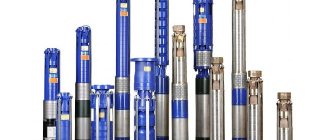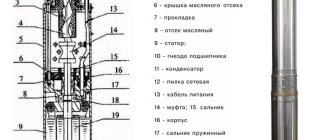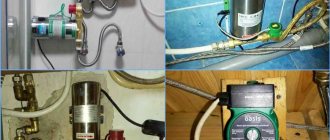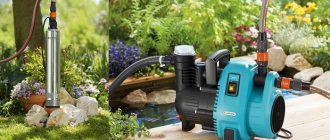If in a country house it is not possible to supply electricity to the well or its supply is unstable, then the way out of the situation is to use mechanical means for lifting liquids, the most effective and affordable of which is a hand pump for the well. The device is useful when owners spend little time in their home and the need for water is low. A simple mechanical unit allows you to supply water to a family for basic household needs and organize watering of garden plants.
Fig.1 Mechanical hand pumps
Popular hand pump manufacturers
The advantages of hand pumps, in comparison with electric ones, are also their disadvantages:
- no need to use electricity . But not all consumers like the use of muscular effort.
- low price . This is beneficial for the buyer, but not interesting for the seller, so this type of goods is represented on the Russian market by a small number of companies
In this market segment, the most popular are imported products from Europe: diaphragm pumps from the Danish company Grundfos, German vane mechanisms. There are many goods from domestic manufacturers: Moscow enterprises, the Ural mining and metallurgical company and others. Hand pumps are produced by the Kauna Iron Foundry ; there are many inexpensive options from Ukrainian enterprises and Chinese manufacturers.
Types of hand pumps and approximate prices of some models
Hand pumps are indispensable in case of temporary or permanent absence of electricity on the site. It is advisable to use them even on a limited budget. If the water level is not deep, and financial capabilities do not allow you to install a high-quality, expensive device, different models of hand pumps will allow you to pump liquid in different ways, depending on the depth and degree of contamination of the liquid .
According to their design, hand pumps for wells are divided into the following types:
- winged;
- piston;
- rod;
- membrane
It is worthwhile to dwell in more detail on the design features, purpose and price of each type of device.
Winged
These are self-priming mechanisms (up to 1 meter “dry”).
Their design consists of a body, a wing, a lever, a suction element, a shaft and several valves. Operating principle: under the influence of a hand lever, the wing rotates, activating the suction element. Simple models cost from 3,100 rubles. If the device body is cast from bronze, the cost of the product is much more expensive: 11,800 rubles - 19,400 rubles. They are designed for pumping and transporting clean water without paraffin, alcohol, liquid fuel, edible oils, or any abrasive particles. Imported pumps K1 and K2 (price, respectively: 4,000 rubles and 5,500 rubles). The Russian pump RK-2 is similar to the German model K2. But the imported version has a price lower than the domestic pump. At the same time, its valves and wings are brass, there is no rust inside. In general, K2 is more preferable for use, does not require reassembly, and is absolutely ready for use.
Rod
They are capable of pumping liquid from depths of up to 30 meters. The design principle of these mechanisms is the same as that of piston pumps. But the end of the piston has a very elongated shape; in fact, it is a rod (hence the name). Product elements are made from various metals that provide the necessary technical characteristics to the devices. Such mechanisms are used in straight vertical shafts. The disadvantages include their bulkiness and the possibility of breaking the rods. In addition, the use of these models on sloping terrain is limited.
Piston
Pumps that create outlet pressure . Such mechanisms can be used to pre-fill non-self-priming electric pumps. The body of the NBU-900 hand pump is made of stainless steel, and the piston ring and seal are made of fluoroplastic. Anti-corrosion materials not only expand the scope of application of the device, but also give a pleasant appearance to the product.
It can be used to pump water, light petroleum products, alcohols, solvents, acids, the kinematic viscosity of which does not exceed 300 cSt. It is impossible to pump water from artesian wells with such devices, but they can successfully replace surface electric pumps for supplying groundwater to the surface. The product has a price of 26,400 rubles.
Membrane
They can be used to pump contaminated water. Thanks to the self-cleaning of the valves , which are rolling balls, the mechanisms do not jam. The design has no rubbing parts (unlike wing and piston mechanisms) that quickly wear out during pumping of liquids containing abrasive particles. The body of such pumps is made of cast iron, and the membrane and valves are made of oil- and petrol-resistant rubber (NBR). In the operating position, the pump is located vertically , with the handle down, the upper nozzle is pressure, the lower is suction. There are 2 ears on the sides of the case for mounting to the wall. Price of a D40 diaphragm pump in Novosibirsk: 7,500 rubles -11,750 rubles. Suction height no more than 6 meters.
Recent Entries
Chainsaw or electric saw - what to choose for the garden? 4 mistakes when growing tomatoes in pots that almost all housewives make Secrets of growing seedlings from the Japanese, who are very sensitive to the soil
Hydraulic
They have low weight (from 4 kg) and small overall dimensions . The devices are designed to work together with hydraulic equipment that has suitable parameters and a spring return rod. Price 4,400 rubles.
: We make an impeller
The pump works as follows: the shaft, rotating in a sealed housing, throws water from the center to the edges of the pump housing; the water then flows out through the outlet pipe.
Make a shaft from aluminum sheet according to photographs.
How to choose a hand pump for a well?
One of the purposes of using hand pumps is to save money (both in the absence of electricity charges and in the cost of the mechanism itself). But price is far from the only criterion for choosing a “metal assistant” on a personal plot. What else matters when purchasing a hand pump?
Well depth. This is the most important selection factor. Conventionally, hand pumps can be divided into 2 groups:
- Mechanisms designed to lift water from a depth of up to 6 meters (9 meters, provided that a check valve is installed at the end of the water supply). Of the types of mechanisms discussed above - membrane, vane, piston.
- Devices capable of lifting water from a depth of up to 30 meters. Rod pumps solve this problem.
Well diameter . It is recommended to drill a well with a diameter of more than 4 inches. In this case, any pump can be used.
The nature and degree of contamination of the liquid. The purpose of pumps in accordance with this criterion has already been discussed above.
Weight and dimensions of the product. These parameters are important for transportation and ease of installation of the product. Weight varies from 4 kg to 130 kg.
Goals . It is important whether there is a need for docking with other devices or whether the mechanism should simply replace the “crane” and “bucket on a rope”.
Installation method. The ability to move from one place to another is important, for example, if water is taken from a river for household needs, and from a well for drinking.
Time of use. There are models designed for year-round use. If the pump is needed only in the summer, you can use inexpensive summer options (their body can be made of plastic).
Decorative. Many models, made in cast iron casing, look very attractive. They are able to decorate the area, give the site individuality and special charm. There are also decorative models that are not designed for pumping water.
Winter or summer water supply
Plumbing in a dacha is not always used all year round. In some cases, it is needed only from spring to autumn, so a simplified summer version is arranged. There is no point in spending money on an expensive capital system when no one lives in the house in winter. The summer water supply will provide watering, a shower is connected to it, and it is used for other household purposes. It can be permanent or collapsible, but in both cases it is not used in winter.
The hoses used are silicone or rubber, which have thick walls reinforced with nylon. Plastic is cheap, but short-lived under the sun. Rubber is more expensive, but will last at least 15 years. At the end of the season, the hoses are disconnected, twisted, pouring out the remaining water, and sent for winter storage.
Permanent summer water supply is laid in shallow trenches so as not to interfere and so that no one is tempted to steal. Only water taps lead to the surface. The difficulty of the construction is that it requires maintaining a constant slope. It goes from the connection point to the lowest point where the drain valve is installed. Water is drained through it before frost.
Installing a winter water supply is more difficult
They take into account the slope of the relief, soil freezing and other factors that are taken into account when constructing a capital water supply system. In this regard, the dacha option is no different from what is done in private homes with permanent residence
Features of device operation
In the presented hydraulic units, all components are unified ; it is easy to find a replacement for them.
Installation and maintenance of mechanisms does not require the use of special tools; the installer only needs to have basic technical knowledge. It should be noted that regardless of their own dimensions, weight, type of mechanism, all types of hand pumps provide approximately equal performance. That is, it does not matter from what depth the water is lifted (from 1 meter or 30 meters), approximately 1 liter of water is released for a full cycle of operation of the moving elements. With the help of hand pumps, you can ultimately “pump up” up to 40 liters of liquid in a minute.
This is significantly less than what automatic analogues can pump. But the choice of a hand pump is justified when water needs are small and there is no electricity on the site. In addition, such models are easy to install and maintain, provide complete independence from external conditions, and will last much longer than electric pumps.
Feasibility of application
Hand pumps for pumping water do not require electrical power or the use of any other energy carrier, which is one of their most significant advantages. Manual water pumps can be used as backup equipment and used in cases where the main electrical device is unable to function due to a breakdown or lack of voltage in the power supply.
An advisable solution is to install a hand pump in summer cottages that the owners rarely visit, only from time to time.
In such cases, it is undesirable to use more expensive electric pumping equipment, which requires regular maintenance and more thorough care. In addition, an electric pump left unattended by its owners for a long time can simply be stolen.
Hand pumps for water are actively used in dachas and country houses that do not yet have a central power supply. In such cases, the use of a manual device for pumping liquids will allow you to obtain the required amount of water both for domestic needs and for watering garden and vegetable plants in the summer.
DIY hand pump for water (video)
- Author: Alexander Alexandrovich Chebotarev
Rate this article:
- 5
- 4
- 3
- 2
- 1
(5 votes, average: 3.8 out of 5)
Share with your friends!
How to choose a brand of submersible pump for a well
High pressure water pumps
: Materials
For the project we use common materials that can be purchased at any hardware store. These are the materials:
Read also: How to make a watermelon basket step by step
- 18 V DC motor.
- PVC adapter 50*32 mm.
- PVC plug 50 mm.
- PVC adapter 32*20 mm.
- Aluminum sheet measuring 60*60*1 mm.
- Plywood sheet 5 mm thick.
- An old bicycle tube.
- A bunch of different screws and nuts.
Tools:
- Drill with drills.
- Screwdriver.
- Saw.
- Metal scissors.
- Pliers.










